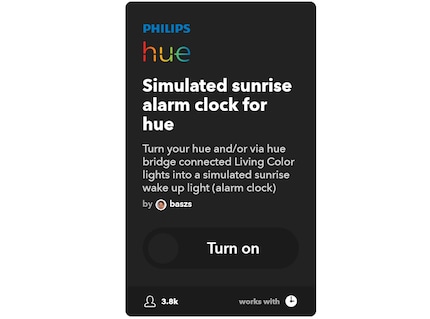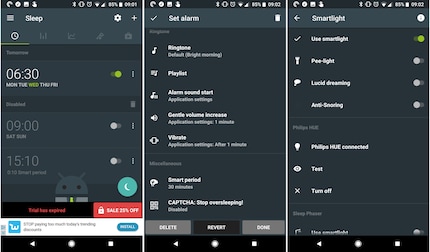

"Build" your own light alarm clock
Light alarm clocks ensure a relaxed wake-up. However, as I don't necessarily want to buy a new alarm clock for this, I have tried to create a solution using intelligent light bulbs.
Alarm clocks are annoying. It would be nicer if you could wake up naturally. That's why there are light alarm clocks. They are designed to ensure that you wake up slowly and are not suddenly jolted out of a deep sleep phase by a shrill beeping sound. Philips and other manufacturers offer so-called wake-up lights for this purpose. Alarm clocks with an integrated light that you place on your bedside table and that gently wake you up with an artificial dawn. However, I don't want to do without the convenience of wake-up apps and want to keep my bedside table as clear as possible.
Luckily, there are numerous smart light bulb systems. A single bulb costs significantly less than a standalone light alarm clock. Depending on the manufacturer, a starter kit may be in a similar price range, but they can be used in many different ways and are not limited to the bedroom.
I opted for Philips Hue as it is the most common system and should therefore offer the most options.

Option 1: Hue app
The easiest way to get a light alarm clock is to use the "Philips Hue" app. Set a wake-up time under Routine > Wake Up and specify how many minutes before the light should switch on. Before that, you should set the colour to an orange tone, as this best simulates dawn. This works quite well, but I would like to have a ringtone for additional security. I can set it separately via the alarm clock app, but then I have to configure two apps every time I adjust the time - too complicated for everyday use. What's more, the light is far too bright right from the start, which is why I wake up at the first flash. Too uncomfortable for my taste.
Option 2: IFTTT
I'm obviously not smart enough for IFTTT. This service allows you to combine and automate various applications. With the existing templates, I can't achieve my desired result. I can either set the light to switch on at the same time as the sunrise, but then I would never get to the office on time. Or the light switches on immediately rather than gradually, which is also unrelaxing. If you have any tips on how to make this work better, I'm all ears.

Possibility 3: The sleep app
The Android app "Sleep as Android" offers all kinds of functions for healthy sleep such as sleep cycle measurement, anti-snoring function, anti-jetlag etc.. I don't need any of that. What's more interesting for me is that the app has Philips Hue integration. To do this, you simply have to activate the Smartlight option in the settings and select when the alarm sound (weird, I know) should start. This is also the time when the light starts to get brighter. It automatically simulates the morning light from reddish to yellow. As far as I know, you can't change the colour yourself. The app is not particularly user-friendly, but it works. You can programme as many alarms as you like and also set a ringtone.

More complicated than expected, but it works
After a lot of trial and error, I finally achieved my goal. I turned my bedside lamp into a light alarm clock without having to put an additional device on my bedside table. You might think that the Hue app would be able to do this, but far from it. At least the Android version is too limited. But that's why there are alternative apps like "Sleep as Android". The app offers numerous setting options, but is unfortunately rather confusing.
The only thing that bothers me about the whole setup is that I can only switch the Hue bulbs on and off via the app. I could use the light switch on my bedside lamp, but if I switch off the power there, the alarm clock will of course no longer work. And I need the remote control supplied for the lamps in the living room. And early in the morning, I find it easier to press the light switch than the off button on my mobile. But what the heck, the main thing is that it works. Thanks to the artificial sunrise, I now (almost) enjoy getting up in the cold season too.
As a child, I wasn't allowed to have any consoles. It was only with the arrival of the family's 486 PC that the magical world of gaming opened up to me. Today, I'm overcompensating accordingly. Only a lack of time and money prevents me from trying out every game there is and decorating my shelf with rare retro consoles.
From the latest iPhone to the return of 80s fashion. The editorial team will help you make sense of it all.
Show all